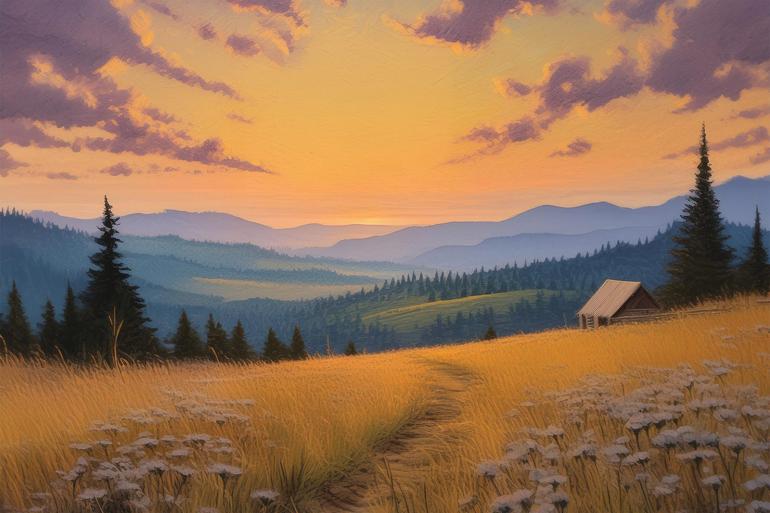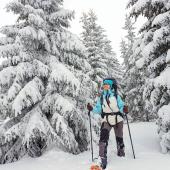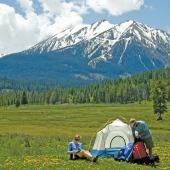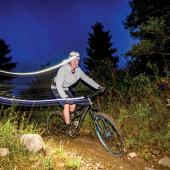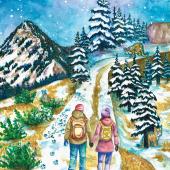Copernicus Revisited
Windy Pass and the mile-long shadows.
If you’re planning to drive Portal Creek to the Windy Pass Trailhead, it might be advisable to make a preemptive appointment for new shock absorbers. Drive too fast and your gizzard will bump into your spleen. But if you take the road slowly enough, it can be merely a roly-poly ride, protecting both your vehicle’s suspension and your innards.
Like many remote spots these days, you might be surprised to find that the parking area isn’t empty. On the plus side, most of your fellow travelers’ cars will display local plates. The hike is a steady one-foot-after-the-other ascent. It’s two-plus miles with about 1,300 feet of elevation gain. Relatives from the flatlands will find it strenuous.
A few summers back, we reserved the Windy Pass cabin for a late-July trek to alpine country. Built in 1934, the log structure is a rustic and reassuring alternative to sleeping on the ground in grizzly habitat. The hard-sided haven makes for a restful alternative to a night in a tent. The cabin has a secure door, and bars across the windows are adorned with medieval-looking spikes to discourage the local ursines. You can doze without keeping one eye and ear open.
Though day-hikes are abundant, sometimes the cabin is a destination in and of itself.
The cabin is ideally situated. You can hike north along the Gallatin Crest Trail and make it back to Hyalite Peak and the reservoir. Travel south and you can go and go, hooking up with other trails, and wind up not far from Yellowstone Park. We once ended a Crest Trail hike by traveling down Buffalo Horn and rewarding ourselves with a steak dinner at 320 Ranch. East takes you to the Big Creek drainage and into Paradise Valley. West is where you just came from. If your mental image of a pass is that of a cresting saddle between two drainages, that’s not how it is at Windy Pass. What you have is a broad expanse of flat meadow. It’s more like looking at a seascape of grass and wildflowers. Annoying flies sometime appear at midday—a nuisance to be tolerated. This is a lovely spot.
Though day-hikes are abundant, sometimes the cabin is a destination in and of itself. The last time we hiked in, after our pasta dinner, we enjoyed a sip of “wine in a mini box,” and we simply headed out into the meadow to gaze west and contemplate the sunset. Like weddings and funerals, you should endeavor to never miss a sunset.
We walked east from the cabin, keeping an eye over our shoulders to watch the sun make its decline. As the sun fell towards the horizon, we rotated three-sixty to take in the entire scene. The sky to the west took on a palette of glowing pink as the sun dipped lower and lower. To our surprise, when we turned east, the thing that caught our attention was our shadows. I’m six feet tall but my shadow was 20 feet long. Soon enough, as the sun descended, my shadow elongated like a spindly stretched Gumby. Soon our shadows were 50 feet and expanding ever further. We were in a unique spot. In general, there’s a limit to how long one’s shadow can become. The sun will dip behind an obstruction; away goes the shadow. Or the shadow bumps into something, again wiping it out. For really longs shadows, an east-west continuum, like at sea, is required. This evening on the plateau of Windy Pass, the conditions were right for world-record shadows. We made our dark images wave happily to no one. We saw hilarity in our shadows doing jumping jacks. The shadowy caricatures got longer and longer, soon looking impossibly long. Add mile-long shadows to the list of nature’s wonders.
Then, something else happened. We were so focused on our shadow puppets, we hadn’t noticed the full moon rising right before us. Behind us, the red ball of sun finally began to drop behind the mountains. In front of us, the moon, looking unnaturally large, was rising in the east. It was a chorus of cosmic wonder.
We were so focused on our shadow puppets, we hadn’t noticed the full moon rising right before us.
We sat in the twilight, mesmerized by our sunset experience. We lingered until the gloaming changed from blue dark to black dark. I wished that Nicolaus Copernicus could have been backpacking with us that day so he could rethink his big discovery. In the 16th century he reversed the world’s notion that the Earth was the center of the universe. We egotistical humans believed the sun and all the celestial bodies rotated around a stationary Earth. Copernicus was said to be a polyglot and a polymath, meaning that he could speak many languages and he knew a lot of stuff about a lot of stuff. But after our Windy Pass experience with astronomy, his heliocentric theory seemed out of whack. What we had just witnessed put the Earth back at center stage. As if they were yoked together, the sun went down, and the moon came up. Plain as day, the Earth was squarely in the middle. It was obvious. Copernicus, his genius notwithstanding, was wrong. He shoulda been there.

